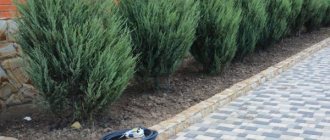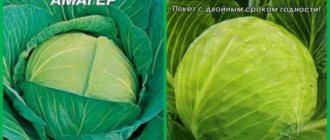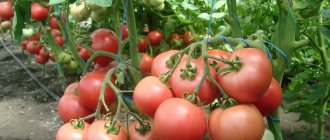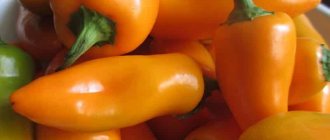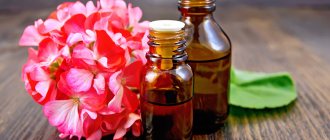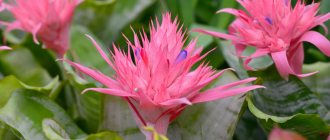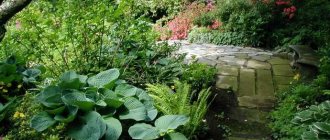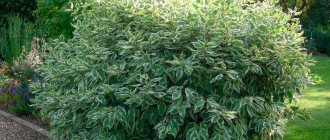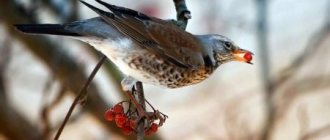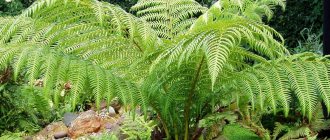Description of salvia, types
All species of this flower, and there are almost 900 of them, are extremely light-loving. Florists call salvia species that are grown exclusively for decorative purposes. Wild-growing individuals are known to everyone under the name “sage”, which is used in cooking and in healing practice.
The shoots of the plant are tetrahedral, erect (sometimes ascending), the height depends on the specific variety, and ranges from 20 to 120 cm. The leaf blades are usually entire, but can also be pinnately dissected. Their outer side is dark green, and the lower side is whitish.
The ends of the shoots are decorated with complex whorled inflorescences, consisting of small flowers and resembling a spike. Sometimes it can look like a panicle and reach a length of 20 cm.
All available types of salvia, depending on biological characteristics and agrotechnical characteristics, can be divided into 3 groups:
- Subtropical species that are cultivated as annuals in the middle zone. They need warmth and constant hydration. May die in light frosts.
- Mediterranean varieties are more frost-resistant and can withstand drought. However, they need loose soil and mineral fertilizers.
- This includes all frost-resistant species . They bloom lushly in the second year, and only need shelter when natural cover is scanty.
Popular varieties
In city flower beds and private flower beds you can often find the bright colors of annual salvia of various colors. Flower growers are most willing to fill their flower beds with the following varieties:
Salvia sparkling
Salvia sparkling is a perennial plant, but in the middle zone it is cultivated as an annual. Compact bushes have a height of 20-80 cm and have fairly dense foliage. The opposite petiolate leaves are ovoid in shape and dark green.
Large flowers of irregular shape are endowed with a double perianth. In addition to the usual red color for this species, others are also often found: pink, white, purple. Salvias bloom from June until the first frost.
The varieties Salvator, Sahara, and Fire Star are very popular.
Salvia vermilion
Straight branching shoots of salvia grow 50-70 cm. The green mass has dense pubescence on the underside, and the front side of the finely serrated leaves is bare. A loose inflorescence of whorled flowers can reach 30 cm in length. Salvia blooms in July and pleases the eye until frost.
Among the popular varieties are: Sherry Bloss, Lady in Red.
Salvia powdery
The pyramidal bush can reach a height of 90 cm. Mealy salvia is quite unpretentious and blooms for a long time. Plants of this species are large - tall peduncles have long inflorescences with 2 centimeter flowers.
Flowering of this type of salvia begins in August. Most often the flowers are blue, but some varieties bloom white.
Flower growers fell in love with the following varieties: Anschuld, Victoria, Strata.
Salvia green
The only decorative variety of green or variegated salvia is Horminum. There are many soft pink flowers on long simple inflorescences. They are very effectively set off by bracts that have rich pink or purple tones.
Popular varieties are: Pink Sandy, Oxford Blue, White Swan.
Salvia whorled
The bush with ascending shoots and dense pubescence is small - only about 40 cm. The leaf blades have an unusual shape; dense whorls contain up to 30 blue-lilac flowers.
The most striking representative of Salvia whorled is the Purple Rain variety.
Salvia dandelionifolia
This herbaceous plant has a basal leaf rosette. Each part of salvia is endowed with a pleasant aroma. The leaves are pinnately dissected, their undersides are pubescent. Simple inflorescences are quite long and can reach 30 cm.
When to plant salvia seeds for seedlings
The timing of sowing salvia seedlings depends on the specific plant variety. Therefore, when purchasing seeds, you need to carefully study the packaging; it should contain specific information: when is the best time to sow seeds for seedlings, when to plant grown plants in open ground. And based on the manufacturer’s recommendations, you need to choose the optimal time for the procedure.
As a rule, the time for planting decorative sage seeds is at the end of February-March , and they are ready for planting in open ground in about three months. But it all depends on the specific variety!
It is necessary to take into account the weather and climatic features of different regions, for example, in the South you can sow as early as mid-February, in the middle zone (including the Moscow region) and in the Volga region the optimal planting time is in early and mid-March, in the Leningrad region, Siberia, In the Urals, it is better to plant the crop at the end of March.
By the way, a very good solution is to plant salvia seeds for seedlings according to the 2021 Lunar calendar:
- Favorable days: in January: 1, 2, 10, 11, 15, 16, 19, 20, 27, 29;
- in February: 17, 18, 22, 23, 24;
- in March: 1, 3, 4, 20, 21, 29, 30;
- in April: 9, 10, 15, 16, 17.
- Unfavorable days: in January: 12, 21, 22, 28;
- in February: 11, 27;
- in March: 12, 28;
- in April: 11, 26.
How to grow salvia from seeds
To grow healthy seedlings, gardeners need seeds, soil, container, diligence, and attention.
Preparing seeds for sowing
Since salvia seeds do not need stratification, preparation of planting material is carried out on the eve of planting. Seed material can be purchased or collected personally. Sometimes bagged goods are already pre-processed and granulated; in this case, it does not need pre-planting treatment and is sown directly into the soil.
However, it should be noted that granular seeds need to be planted a little earlier than usual, since it takes some time to dissolve the artificial mineral shell.
Simple seeds are subjected to the following treatments:
- Germination test. Place the seeds in a deep plate with warm water for 1.5 hours. Then the water with floating pacifiers is drained. High-quality seeds are collected at the bottom.
- Disinfection. The grains wrapped in a piece of bandage are kept in manganese for a third of an hour, followed by washing.
- Drying. Before planting, the seeds are dried on a sheet of paper. To prevent the core from drying out, do not place the grains on the battery.
Selection of soil mixture
If you don’t want to buy ready-made soil, it’s easy to prepare it yourself. Salvia puts forward the following requirements for it: nutritional value, lightness, water permeability.
You will need coarse sand, peat and leaf soil. A well-mixed mixture will need to be re-sowed twice:
- Place on a large sieve;
- Place in a fine sieve.
The containers are filled as follows:
- The very bottom is lined with expanded clay, approximately 1 cm thick;
- Half the container is filled with coarse soil;
- Next, add fine soil.
To destroy possible pests, the soil is watered with hot, strong potassium permanganate and left to rest for a week.
Sowing salvia seedlings in containers
Any low container is suitable for salvia seedlings. To prevent stagnation of water, the bottom is pierced several times. Ready-made factory containers already have holes and are equipped with pallets.
- The soil is pre-moistened so that the seeds stick better. Some gardeners mix salvia seeds with sand to ensure more uniform planting and prevent thickening. Granular material is larger and easier to sow, so the seeds are placed in a 3x3 pattern.
- The spread out seeds are lightly sprinkled with earth. Often gardeners simply press them lightly into the soil. The container is covered with glass or film.
Seeds germinate within 8-12 days. The temperature is maintained around +22ºС. The sprouts almost always emerge with a seed cap, and it is advisable to help them get rid of it.
How to sow salvia, the best way - video
Step-by-step guide to planting salvia seedlings
Planting seeds for seedlings is a complex undertaking that requires high-quality implementation of all stages: selection of seed, planting container, preparation of seeds and soil, and direct sowing using the correct technology and scheme. This step-by-step guide will help you plant salvia at home as efficiently as possible:
Seed selection and preparation
The choice of planting material must be taken responsibly. Poor quality seeds or expired material are unlikely to produce healthy seedlings.
It is recommended to buy seeds in specialized stores, points of sale and online stores that have a good reputation and have positive reviews from real customers.
The package with seeds must indicate all the necessary information : expiration date, information about the variety, dates of sowing, planting, flowering, etc. (a good example is in the photo below).
Before sowing, it is recommended to disinfect the seeds . To do this, place them in a fabric bag or gauze and immerse them in a pink solution of potassium permanganate for 15 minutes. And then rinse in running water and dry.
Important! If you buy pelleted seeds (that is, in a special shell), then there is no need to prepare them; they are already completely ready for sowing.
Soil preparation
You can either buy soil for sowing seeds and growing salvia seedlings at a store specializing in gardening supplies, or prepare it yourself at home. The main thing is that it is light, fertile and neutral soil with a pH of 6-6.5 . It is in this soil that the seedlings will be most comfortable.
You can prepare a soil mixture at home by mixing forest soil, lowland peat and clean river sand in a 1:1:1 ratio.
You can also make another soil mixture: 2 parts leaf soil, 2 parts peat, 1 part coarse sand.
If you do not have the opportunity to prepare a substrate, then you can buy universal soil for flower seedlings . But you should add a little sand there to improve the structure.
Selecting a landing container
Various containers can be used as a planting container for sowing seedlings; each gardener chooses the appropriate option depending on capabilities and preferences.
Flower seeds can be planted at home in:
- peat cups;
- plastic cups;
- plastic cassettes;
- box (it can be made of plastic or wood).
Important! No matter what kind of planting container you have, it should have drainage holes that will protect the plants from dangerous stagnation of moisture.
Salvia seed sowing scheme
The technology for sowing plant seeds is very simple; even a novice and inexperienced gardener can cope with the task. If you are one of them or are encountering this crop for the first time, then a step-by-step scheme for planting salvia seedlings will come to your aid:
- First of all, it is recommended to pour a drainage layer on the bottom, the thickness of the layer is one centimeter; you can use, for example, expanded clay.
- Fill the planting container with soil; there should be a gap of 2-3 centimeters between the edges of the container and the ground.
- Then you need to water the substrate thoroughly.
- Now you need to sow the seeds, and since they are very small, for convenience and uniform distribution you can mix them with coarse river sand and scatter them over the surface of the soil.
- There is no need to cover the seeds with soil, just gently and very slightly press them into the soil with your palm.
- Spray the crops with settled water from a spray bottle.
- Cover the planting box with glass or film to create a mini-greenhouse.
If you want to sow seeds in peat tablets , you can do that too. For planting, you need to prepare peat products - put them in a container, fill them with warm water, let them swell for 30 minutes, then transfer the seeds to the middle of the peat tablet (preferably 2-3 seeds at once, so that you can then select the strongest sprout). The container with tablets must also be covered with a lid, glass or film.
With proper sowing of seeds and subsequent care, the first shoots will appear in about 7 days. But most likely, not all the seedlings will sprout at the first stage, but there is nothing strange or dangerous in this, the rest of the seedlings will “catch up” to the leaders in about one or two weeks.
Caring for salvia seedlings
The emerged seedlings begin to open gradually, lifting the glass for a short time, increasing it daily.
Lighting
Seedlings need light for 12 hours, so additional lighting is indispensable. The container can be placed on window sills, but be sure to turn on additional phytolamps in the morning and evening.
Humidity and watering
From the moment of sowing and in the future, the soil should not be allowed to dry out. Moisten the seedlings with a spray bottle, or by pouring water into trays, from where it is absorbed into the soil through the drainage holes.
Excess moisture causes rotting of the roots, so it is better to dust the surface with ash.
Feeding
3 weeks after germination it is useful to feed them. Use complex formulations purchased in stores. To activate the growth of salvia, use Fertika and Agricola fertilizers.
Picking
For salvia, as for any seedling, a strong root system is very important. This can be achieved by double picking.
The first peak occurs during the period of 1-1.5 months of plant life. This is not too late, since salvias are slow-growing. In any case, diving is not done earlier than before the appearance of 2 permanent leaves.
Transplantation is usually carried out into the same containers, only at a greater distance. Can also be transplanted into individual containers. The distance is maintained at about 7 cm; deepen to the cotyledon leaves. Picked seedlings should be covered with paper for a couple of days.
3 weeks after the first pick, the procedure is repeated. The containers chosen are sufficiently capacious, since salvia roots grow well.
Picking salvia allows you to solve problems that will be useful to the plant throughout its life:
- Root development is stimulated;
- During picking, it is possible to select the strongest plants;
- Interweaving and, as a consequence, deformation of the roots are prevented;
- When picking, seedlings are examined to identify diseases and prevent them;
- Seedlings that begin to outgrow are buried a little deeper to slow down their growth if it is too early to plant.
After 4-5 leaves appear, the top of the seedling is pinched, causing maximum tillering. A couple of weeks after picking, salvias notice increased growth.
How to properly pick salvia seedlings - video
How to plant Salvia brilliantis correctly
Many gardeners ask the question: when to plant salvia seedlings? You need to do this as early as possible if you want to see bright flowers in June or July. Salvia seeds are most often planted at the end of February or March. Keep in mind that flowering occurs 3-4 months after sowing. Salvia is bred at home in two ways:
- Seeds. In this case, the seeds are sown directly into the ground in late autumn before frost or in spring. This method, however, is not suitable for all flower varieties. Species such as subtropical salvia brilliantis are planted only as seedlings.
- Seedlings. To obtain seedlings, from mid-February to the first ten days of March, seeds are sown in plastic containers equipped with drainage holes at a shallow depth. The soil in the boxes should have good drainage, be loose and moist. Seeds are provided with constant moisture by spraying the ground or placing the box in a tray of water. The top of the box is covered with film or plexiglass. The temperature for seed germination should be at least 25 degrees.
Photo of purple salvia
Salvia is a sun-loving plant according to the description and photo, so the box with seedlings is placed in a bright, sunny place. After the shoots emerge, which will happen in 2-4 weeks, the sprouts are planted in another box, leaving a distance of 5 cm between them. After another three weeks, the plants are picked again, transplanted into separate pots with a diameter of 10-12 cm. In these pots Salvia seedlings are grown until 3-4 leaves appear. To obtain a beautiful, lush bush, the top of a grown seedling is pinched.
When to plant salvia in open ground
At the end of May - beginning of June, after warm weather has established and in the absence of night frosts, salvia seedlings are planted in open ground. The composition of the soil as described should be the same as what you used for growing seedlings from seeds. Before planting, young plants are hardened off by gradually lowering the night temperature.
Photo of salvia in a flowerbed
To plant salvia, prepare holes at a distance of approximately 20-25 cm from each other. If the soil at the site of future planting is dense, it is loosened, moistened and humus is added. The place reserved for salvias on the site should be bright and sunny, protected from wind and excess moisture.
How to care for salvia after planting
Caring for salvia, as described by experienced summer residents, is simple; it includes several basic tasks. Salvia should be watered as the soil dries out. The plant loves moisture, but reacts poorly to stagnant water. In very waterlogged soil, the roots of the plant may rot.
Loosening the soil and weeding are done some time after watering. The plant loves light soils, so the soil is loosened as it hardens in order to saturate it with oxygen. Plants are fertilized 2-3 times a season. Complex mineral fertilizers based on nitrogen are used.
Photo of salvia brillianti
Pruning is carried out before the growing season and before winter. This procedure allows you to form a lush bush. During pruning, faded flowers, dried and woody branches are removed. As a rule, according to reviews from gardeners, salvia is not susceptible to diseases and pests. However, if insects and aphids are detected, they are treated with insecticides.
In late autumn, after flowering has ended, shrubs that remain to spend the winter in the garden must be pruned as described, the growing points covered with mulch or compost, and if a winter with little snow is expected, the plant must be covered completely.
These simple steps include proper care for powdery or shiny salvia. Descriptions and photos of salvia flowers will help you decide whether it is worth planting seeds or seedlings of this plant on your own site to decorate your landscape design.
When to replant salvia in open ground
Like all heat-loving crops, salvia does not like frost, so it is planted only after stable heat has developed. In the middle regions this is approximately the first ten days of June.
The planting holes need to be spacious so that the roots do not clump together. Add superphosphate or ash and a handful of humus to each hole. It is better to plant during periods of less sun activity, or shade the seedlings for 3 days.
When choosing a place for salvia, you need to pay attention to some nuances and immediately make adjustments for the location:
- Salvia is prone to lodging. The seedlings are either covered with soil or planted thicker.
- The activity of flower development may interfere with other plants. You need to maintain a distance of 30 cm.
Types and varieties of salvia with photos
Until recently, only two forms of brilliant salvia were known: tall - 80-90 cm and low-growing - up to 50 cm. The latter was used for carpet flower beds and as a potted plant.
Low-growing salvia has several varieties, characterized by an accelerated development cycle (they bloom 60-65 days after sowing):
Now there are varieties of salvia with purple flowers:
As you can see in the photo, this salvia variety is a compact bush 35 cm high and 38 cm wide:
Wide range of vibrant colors such as scarlet, hot pink, light pink, purple and white. The seeds of this hybrid are of very high quality. They are smaller than ordinary salvia, there are 270 pieces in 1g.
Another type of salvia - Horminum, which is also grown from seeds through seedlings, has a completely original color, not similar to the traditional red plant.
Pay attention to the photo - salvia flowers of this species have bright multi-colored bracts (pink, blue, lilac, white). Plants of this type of salvia are low-growing (35-50 cm), good for decorating flower beds, flower beds and for cutting
They are also heat-loving, light-loving and moisture-loving, but, unlike other salvias, they are cold-resistant. Flowering is long-lasting, begins 70-100 days after germination
Plants of this type of salvia are low-growing (35-50 cm), good for decorating flower beds, flower beds and for cutting. They are also heat-loving, light-loving and moisture-loving, but, unlike other salvias, they are cold-resistant. Flowering is long-lasting, beginning 70-100 days after emergence.
So that your balcony or garden is buried in pink clouds from June until frost, be sure to find a place for Salvia Lavender. Its flowers resemble fluffy tails, and therefore it can become the highlight of the garden.
Possible problems with seedlings and their solutions
Salvias are practically not susceptible to any diseases. The damage is caused by insects and slugs, which can be successfully combated using traditional methods. Often, when growing seedlings, gardeners are faced with some unpleasant situations:
- Shoots do not appear for a long time . This situation can be observed if the swollen seeds were still overdried. It is best to sow again, since even if the previous seeds sprout, the sprouts will not be completely healthy.
- The sprouts stay in their caps for a long time. Seed skins remain on plants for a long time if the seed material is not of high quality. The seedlings should be slightly moistened and, using a toothpick, help get rid of the seed coat. Then the seedlings are fed with complex microelements.
- Flowering is delayed or completely absent . If the plant has pale foliage and the stems are very elongated, it means the whole problem is a lack of light. Salvias are quite demanding about this: no light - no color. If the problem is noticed at the beginning of summer, then you can try to transplant to a sunnier area. If the bush develops normally, the color is natural, rich, and there are few or no buds, then the salvia is simply fattening from excess nitrogen. In this case, it is sprayed with superphosphate.
Annual plants
As already mentioned, mainly in our climate, the tropical perennial salvia is grown as an annual ornamental plant. Different types of salvia differ in their biological characteristics; a description of the most popular of them is given below:
- 1In the flower beds of parks and gardens, sparkling or shiny salvia is most often found. Bush 20-80 cm high (depending on the variety). Plants with large irregular bright red pyramid-shaped flowers are known to everyone, although there are varieties with white, pink and purple buds, differing in the size of the racemes and flowering periods. Compared to red salvia, sparkling white has a less dense inflorescence, purple has more dense pubescence, and pink has a short flowering period.
- 2Salvia Mealy is a plant 60-90 cm high with loose inflorescences 15-20 cm long, predominantly blue-blue in color, located on high shoots. The Anschultz variety has silver-white flowers. Drought resistant.
- 3 Salvia red has straight, densely pubescent stems, ovate leaves and loose inflorescences up to 30 cm long.
Among the numerous species, salvia variegated stands out. It is original with its bright leaves-bracts, which are pink in color with green veins, giving the plant a decorative appearance before the flowers appear and throughout the growing season. However, this species is not used in culture due to the need to use supports, without which the plant will lie down.
How to properly care for salvia in summer
Salvia is very easy to care for. Simple standard procedures include watering, weeding, mulching, loosening, and fertilizing.
What to feed for abundant flowering
In order for salvia to delight with an abundance of color, it needs proper nutrition. In the flowerbed, flowers are fertilized 5-7 days after planting. The menu offers her growth stimulants and minerals. As soon as the plant begins to form buds, the next feeding is carried out.
Salvia will bloom abundantly if it manages to develop its above-ground part well. Like nothing else, this is facilitated by nitrogen, found in proper quantities in bird droppings, humus, and manure.
The infusion of such organic matter should be poured over the transplanted salvias, and in a very short time they will become much healthier. Flowering is also promoted by potassium, which helps absorb water and phosphorus, which ensures normal development.
Salvia Cassiopeia
Some flower growers who do not have the proper experience and are poorly versed in various fertilizers can use tips from manufacturers. Many nutritional compositions speak for themselves: Ovary, Bud, and so on.
Experienced flower growers prefer traditional methods to all factory-made fertilizers. To prolong and enhance flowering, they use an ash solution. Also pour boiling water over the skin of bananas and peel potatoes for a week.
Before the buds open, it is useful for salvia to water it with water infused with egg shells.
Reproduction methods
Salvia reproduces in several ways. Perennial varieties can be divided from the rhizome, propagated by cuttings, and sown by seeds. But one-year-olds and biennials are propagated exclusively by seeds: direct sowing and through seedlings.
Seeds are sown in spring and autumn, before winter. However, there are varieties that can only be grown using seedlings. These are all varieties belonging to the type of salvia sparkling.
When and how to collect your seeds
High-quality material will be obtained exclusively from varietal flowers. Fading inflorescences are cut and dried. Do this not in the sun. The inflorescences are laid out under a canopy in the fresh air or in a ventilated room. You can collect a lot of seeds from dried seed pods.
Preparing and planting seeds
Before you start directly planting seeds, you should prepare the container, soil and planting material itself.
For planting, you can use any container with low sides:
Latest posts 5 Japanese plants that take root well in central Russia How I protect seedlings from my curious cats What is important to do with coniferous plants in your garden in the spring
- homemade boxes,
- store containers,
- cut plastic bottles,
- cups.
There should be holes in the bottom of the container to prevent stagnation of water and rotting of seeds or sprouts. A layer of drainage, such as expanded clay, pebbles, eggshells or sphagnum moss, must be placed in the planting container.
The soil for plants should be easily permeable to air and moisture. A mixture of soil, peat and coarse sand in a ratio of 1:1:0.5 is suitable for planting.
The day before planting, planting material should be prepared.
Seeds can be purchased or collected with your own hands. In both cases, you need to do the following:
- Suitability check. You need to pour warm water into a bowl, pour the seeds into it and leave everything for 1.5 hours. Seeds that sink to the bottom are suitable for planting, and those that float on the surface of the water are “dummy”.
- Disinfection. Salvia seeds must be wrapped in gauze and placed in a weak manganese solution for 20 minutes. Then they need to be washed in clean water.
- Drying. To evaporate excess moisture, the seeds should be dried naturally throughout the day. There is no need to place the seeds near a radiator or other heating devices, so as not to dry out the core.
Landing
Having prepared the container, soil and planting material, you can begin planting salvia seeds:
- Fill the container with soil until there is 3 mm left to the top of the sides.
- Compact the soil with your hand, then spray with water using a spray bottle.
- Place the seeds on the surface of the soil at a distance of 2 cm from each other. It is necessary to cover the seeds with a millimeter layer of soil.
- Cover the container with film or glass and place it in a warm, lit place, for example, on a windowsill. The optimal temperature for seed germination is 20–22°C. Overwatering should be avoided.
Seedling care
The first sprouts of salvia will appear 14-20 days after planting the seeds. From this period, film or glass will no longer be needed. To prevent plants from starting to actively stretch their shoots, the temperature should be lowered to 16–18°C.
If the sprouts sprouted in winter, it is advisable to provide the plants with artificial lighting. Watering should be moderate so that only the top layer of soil is moistened. When watering salvia, you should avoid getting water on the plant stem.
A few weeks after the shoots appear, it is useful to fertilize. You should choose fertilizers with a complex composition of organic and mineral substances.
Plant picking is carried out when the second leaf appears. It is necessary in order to remove the weakest plants, and plant strong seedlings in separate containers. When picking seedlings, the shoots should be slightly buried in the soil. This will help strengthen the root system.
After the third pair of leaves appears, pinching should be done so that future bushes are thick and lush. To do this, you need to cut off the top of the shoot.
How to grow perennial salvia
These flowers are planted once, and they will delight you with their blooms every year. There is no need to tinker with seedlings or prepare beds for direct sowing every time. Perennials are planted in metropolitan areas, in dachas, and can be found in meadows under natural growing conditions.
They are distinguished by a more powerful root system, which allows the plant to take care of itself, extracting precious moisture from the deep layers of the soil. Their stems are thicker, often with already lignified shoots.
Popular types
The most popular perennials planted in city flower beds are:
- Salvia oakberry. The stems of the plant are relatively low - only up to 60 centimeters. The lower petiole plates are always larger than the sessile ones located above. The inflorescences consist of several lateral branches.
The standard predominant color of the flowers is blue-violet, but the rather large purple bracts often catch the eye. The flowering of the Salvia oak grove species lasts 2.5-3 months: from late June to mid-September.
Plumosa
The most popular varieties are Amethyst (pink-violet), Mainakht (blue-violet), Plumosa (lavender).
- Salvia sticky. The bushes grow quite large - almost 1 meter. The flower has a large number of pubescent glandular shoots. The leaves are more like triangles of yellow-green color with a serrated edge. Salvias bloom towards the end of summer and bloom until frost.
Salvia glutinosa
- Salvia
nemorosa '
Rose Queen'
.
The low half-meter bush is distinguished by its long flowering time. Spike-shaped inflorescences can have different shades, depending on the variety
Salvia Rose Queen
Popular varieties are: snow-white Snow Hill, and dwarf varieties - Blue Queen (lavender), Rose Queen (pink).
Perennials include popular species of Ethiopian salvia and meadow salvia.
Features of cultivation and care
Perennial salvias are more difficult to care for. Many inexperienced flower growers are often perplexed about this, because, it would seem, there is no need to bother with seedlings and the plants are much hardier. However, not everything is so simple: perennials need sanitary and formative pruning, preparation for successful wintering.
In the spring, the bush is formed by cutting off shoots that are too elongated, not allowing them to become bare. After flowering has finished, all inflorescences should be removed. Just before the cold weather, all the old stems are cut off from the plant, leaving small stumps with buds, as well as young greenery.
It is advisable to cover the salvia for winter dormancy - if the winter has little snow and frost, the roots of the crop may be damaged and the flowering next year will not be so generous. Flower beds are covered with sawdust, spruce branches, and dry leaves.
Botanical description
A perennial plant 20–70 cm high.
The root is woody, powerful, branched, densely fibrous at the bottom.
The stem is straight, branched, heavily leafy, woody below, herbaceous above, tetrahedral, dying in the upper part in winter, whitish-woolly with long wavy hairs.
Leaves of vegetative shoots and stem oblong opposite, 3.5-8 cm long, 0.8-1.5 (up to 4) cm wide, obtuse or sharp, wedge-shaped or rounded at the base, finely crenate along the edge, wrinkled, lower and middle on long petioles, the upper ones are sessile. Bracts are lanceolate, sessile, several times smaller than stem ones. The venation is reticulate. The leaves are densely pubescent, gray-green.
Inflorescences are simple or branched, with six to seven arranged 10-flowered false whorls; calyx 9-10 mm long, cut almost halfway into two lips; corolla purple, twice as long as calyx; the column protrudes slightly from the corolla; stigma with two unequal lobes.
The fruit is a nut, 2.5 mm in diameter, almost round, dark brown, dry, of four lobes.
Biological features
In the first year of life, sage forms a powerful bush by autumn.
The plant is cross-pollinated.
Blooms in June - July. The fruits ripen in August - September. Begins to bloom in the second year. Seeds remain viable for three years.
Salvia in the flowerbed and flower beds - photo
Salvia is a very popular flower. It is most often planted in flower beds and flower beds. Salvia looks good in flowerpots or garden containers, which can be placed on balconies and well-lit garden areas. Bright salvia goes well with many types of ornamental plants: lobelia, marigolds, petunia, zinnia, ageratum, alyssum, silver cineraria.
Salvia combined with lobelia
Salvia with marigolds
Perennial Salvia
Salvia with cineraria
Salvia brillianti
Salvia horminum
Salvia Purple
Salvia (sage) flowers - description
The tetrahedral, erect or ascending, simple or branched stems of salvia can reach a height of 120 cm. The opposite leaves, located on long petioles, can be entire or pinnately dissected. Sage leaves are dark green on the upper side and lighter green below. Salvia flowers with a two-lipped corolla, the color of which varies from white to purple, form complex whorls of spike-shaped or paniculate inflorescences. The upper lip of the flowers is straight or crescent-shaped or helmet-shaped, the lower lip consists of three lobes, the middle of which is usually much larger than the lateral ones. The salvia fruit is formed from four nuts filled with seeds.
Picking seedlings: how and when
https://www.youtube.com/watch?v=5aXDzppudK0
Diving is transplanting seedlings into new, freer containers. It must be carried out when most of the seedlings have become stronger and have grown a couple of leaves. If you took small peat cups for the seedlings from the very beginning, then it will be enough to plant them in the same, but larger peat containers.
Sequence of transplanting seedlings:
- Prepare new containers for replanting. The mixture for the soil is made in the same way as the first stage.
- When the container is already filled, make a small depression in the middle of the soil for the replanted plant. It is better not to use large boxes for many shoots at this stage. The best option would be medium-sized pots.
- Before transplanting, you need to water the shoots thoroughly - the water will loosen the soil.
- It is necessary to remove plants along the edge of the container, carefully separating the soil from its inner surface. It is most convenient to use a plastic knife or spatula for this.
- Remove the shoots along with the soil, being careful not to damage the roots, and place them in the recesses in a new location. It is better not to replant frail and frankly weak shoots. The shoot should be obvious, strong and with a pair of leaves.
- After transplanting, water the plants a little again.
Salvia plant and its features
Like most perennial exotic flowers, only a few salvia flowers survive Russian winters.
Therefore, mainly only annual varieties grow on the territory of the Russian Federation, while their parents are perennial. The stem can reach over one meter in height, and is covered, like ears of wheat, with oblong inflorescences up to 20 cm long. The flowers themselves are either dazzling with hot red tones, or sparkling with cold blue and purple buds. There are also varieties with white flowers.
The name salvia, which is unfamiliar to some people, also has another, popular name - sage. It is believed that sage is a medicinal plant, and salvia is an ornamental plant. Although experts say that in fact there is no difference between them. The plant can be either annual or perennial. In both the first and second cases, sowing and growing seedlings is possible.
Now there are about 900 species of plants. But the most popular species are: Salvia sparkling or Sage brilliant, as well as Salvia officinalis.
Sage was originally used for medicinal purposes. It is especially effective against inflammatory diseases, and also has a generally beneficial effect on the body. In addition, sage is successfully used in cosmetology.
Thanks to the efforts of breeders, the plant is now highly decorative; every gardener and vegetable gardener can choose salvia with suitable parameters and colors. The height of the plant can vary from approximately 25 to 80 centimeters. Now there is decorative sage in beautiful white, red, pink, lilac, and blue colors.
With this plant you can create interesting and beautiful compositions by planting salvia of different colors in the flowerbed. The plant looks great in flower pots, ordinary flower beds, rock gardens, and stone flower beds.
Growing a plant from seeds is not a complicated process, and planting and caring for seedlings is not much different from sowing seeds of any other crop and requires a lot of effort.
This plant was first discovered in Eurasia and America. Currently, science knows about eight hundred varieties of salvia. You can also see photos of some types of flowers in our article.
Bright salvia inflorescences are presented in a wide variety of colors. The shade of the flowers will depend on the specific species. In the photo with salvia flowers you can see that its leaves are semicircular and swamp green. The fruits consist of four nuts.
In frosty climates, this crop is planted as an annual plant. In addition to its decorative purpose, salvia is also distinguished by a large number of useful substances that are used in pharmacology. The name of the plant itself comes from the Latin word salvus, which translates as “to be healthy.”
This type of flowers, leaves and fruits affects the body as a hormone-regulating, anti-inflammatory, and antimicrobial agent. You can also brew tea with sage, which helps fight excessive sweating, cure purulent skin diseases, improve the condition of the gastrointestinal tract, and also improve the human immune system.
The height of the plant can sometimes be more than 90 centimeters, and when growing a perennial plant it can reach up to 120 centimeters and form either a bush or a semi-bush. In temperate and cool climate zones, Salvia grows for one or two years. Today there are both red, white, pink and purple plants.
The leaves of the plant are mostly pinnately dissected, although plants with entire leaves can also be found. Salvia is characterized by small flowers that form at the end of the peduncle into inflorescences that externally resemble a spike or panicle. The length of the inflorescence reaches 25 centimeters. The fruit is capable of producing up to 4 nuts.
Seeds and plants ripen a month after the start of flowering. You can collect seeds with flowers no earlier than a month after they fall. The germination of such seeds reaches five years of age. If two-year varieties are grown, the seeds must be planted only in the fall and be sure to cover them for the winter.
Salvia is a flower that can decorate not only a flower bed, but also any other area, as it blooms throughout the summer, until the first frost. Salvia has a variety of colors, which allows you to create multi-level flower beds. The level of air pollution in no way affects the plant, which makes it possible to grow it even in large cities in large flower beds.
Features of cultivation
When numerous shoots appear, the container must be moved to a lighted place, for example, a windowsill. Since daylight for seedlings should last at least 12 hours, and in February the days are still too short, light illumination is provided for seedlings in the morning and evening hours. This condition is considered mandatory, since with a lack of light, the sprouts very quickly stretch and weaken, and it is impossible to inherit strong plants from them.
Lighting and temperature
The main point of producing strong, healthy seedlings is the correct lighting and maintaining a suitable ambient temperature. It should be +25 degrees Celsius during the day, and not lower than +20 degrees at night. In early spring, including on a sunny day, there will not be enough natural light, so place the boxes with salvia seedlings during the day in the brightest and warmest place, if necessary, providing heating and light using fluorescent lamps.
Little by little, salvia seedlings should be hardened off: to do this, remove the film from the boxes for a while every day. Start with ten minutes a day, gradually extending this time. The film can be removed when the seedlings gain strength.
Watering and fertilizing
Moisturizing should be systematic, but moderate. The glass is removed only for a few minutes a day for ventilation in order to create an optimal humidity level for the seedlings. For watering, use a sprayer or pour moisture into a tray, from where it will gradually be absorbed into the substrate. When overwatering, the bases of the sprouts rot and darken, so carefully inspect the plants every day.
Advice! If the plants begin to rot, you need to remove the cover from the box and sprinkle the surface with cleaned wood ash.
Since the plant is planted once or twice in the spring, constant feeding is most often not required. An exception may be when the soil for seedlings is poor in minerals and the foliage has a dull appearance. For feeding, complex fertilizers in very low saturation are used.
Picking
Salvia seedlings are a real slow-witted plant when it comes to growth - it comes to picking only a month and a half after sowing. If you come across a “very fast” species, focus on the leaves - salvia should be picked when two true leaves form on each plant.
Gently pick up the sprouts with a fork or small spatula for replanting and drop them into separate containers. Containers for salvia seedlings should be about 10 centimeters in diameter and 15–20 centimeters deep. The same soil in which you sowed the seeds is suitable.
After picking, carefully water the bushes and cover them from direct sunlight with newspaper - they will be in a stressed state for the foreseeable 2-3 days, and the sun’s rays can burn them. Continue to water the harvested salvia seedlings 1-2 times a week.
When three pairs of true leaves form on the bush, it should be pinched. In this case, it will be more lush, but flowering will be delayed by 1–2 weeks.
Pinching
The next important step in propagating salvia seedlings is pinching. It is done when at least three to four pairs of leaves are formed on the bush. Pinching is done by breaking the growing point between the third and second pairs of leaves or above the third.
Until the plant is planted in a permanent “habitat” in the garden bed, it needs to be hardened off. For this purpose, it is enough to ventilate the seedlings, starting from two to three minutes daily, gradually increasing the time. It is recommended to gradually reduce night temperatures, bringing them to +10 degrees before planting.
Diseases and pests
These flowers are very rarely infected with fungal spores, so we will not focus on diseases. As for harmful parasites, they, like many other flowers, are attacked by whiteflies, thrips, aphids, mites, and of course slugs and snails that devour the soft leaves of the flower.
Snails and slugs are usually collected by hand or baits are made into which they crawl. After which they are removed and destroyed.
Insects are controlled using appropriate insecticides.
The best protection against parasites is prevention, which must be carried out throughout the entire growing season of plants.
Salvia plant and its features
Gardeners value this flowering plant for the bright red color of its flowers and long-lasting flowering; it is used for flower beds, edgings, balconies, window sills, garden vases and potting.
Photos of salvia flowers clearly show how beautiful this plant can be if you follow the rules of care and cultivation. But what are they? It should be remembered that this crop does not tolerate windy weather. She prefers to grow in a warm and well-lit place. Only salvia adhesive requires partial shade for successful cultivation.
In our article you can see how neat salvia flowers grow. In the photo, the flowers are beautiful and miniature, which allows them to be planted in small spaces, decorating personal plots. It is necessary to subject the plant to formative pruning annually if we are talking about perennial varieties.
How to properly fertilize a salvia flower? The first fertilizing is applied immediately after planting. This must be done in order to accelerate the growth and development of the flower. The salvia flower should receive the second dose of nutrients during the formation of its buds. Please note that in heavily fertilized soil the crop will bush abundantly, but will not delight you with powerful flowering. If you follow these simple rules, your salvia will look very vibrant all summer long.
Perennial varieties of salvia flowers, photos of which you can see in the article, are propagated by air layering or cuttings. If you use the second method for propagation, then the cuttings must be divided into two parts, each of which should be approximately 18 to 30 cm. Next, they are placed in water for rooting.
If you propagate your crop by air layering, then the plant branch must be pressed to the ground and secured. It is important to pay attention to the fact that green pets cannot be planted close to each other, as there is a risk of hybrid formation. After a few months, new roots will begin to sprout, and the branch can then be cut off from the main bush. Planting at a permanent location should take place in early April.
Now let's take a closer look at the most popular varieties of salvia flower. Photos of flowers of some varieties can be seen below.
Immediately after planting the seeds, it is necessary to place the seedlings at a temperature of about 25 degrees. Sometimes, for this purpose, containers with it are specially wrapped in warm scarves. If you have a sensitive thermometer for measuring soil temperature, it will come in handy.
Ventilate your mini-greenhouses for 20-25 minutes every day. Monitor the humidity in the containers: wipe the condensation from the film or glass; if there is a need to slightly moisten the soil, use a sprayer for this. The flower requires such care until the first shoots sprout.
After the first shoots appear, there is no need to further insulate the containers: the film is removed, the glass is put back in its place until next time.
Do not forget that salvia is a tropical plant - it loves warmth and sun. The optimal length of sunny day required for shoots is twelve hours. Therefore, it is necessary to place the shoots in a sunny place and fill the missing hours of sunlight with lamps.
It is necessary to water moderately, but without allowing the soil to dry out - on average once every 3-4 days. For watering, you can use any small vessel, preferably with a long neck. When watering, you should not allow water to get on the shoots themselves - they are watered closer to the soil, which is why they need a long neck. Even a drop of water remaining on a leaf can play like a lens in the sun and burn it.
Water for irrigation must be settled and at room temperature.
It doesn’t hurt to feed the capricious plant. A universal flower food is suitable for this. It is enough to add it once before the dive, and again after two weeks.
Diseases and pests
Salvia gets sick so rarely. But with pests the situation is much more complicated. Ornamental sage is a favorite among whiteflies, aphids, mites, thrips, slugs and snails. The delicate foliage of the plant literally attracts various pests.
Slugs and snails will have to be removed manually, bait traps will have to be laid out in the form of slate fragments or rags (slugs will crawl under them). Use beer and fruit juices as bait. The pleasant smell will attract gastropods, so you can collect all the slimy reptiles in one go. Insects can be controlled with universal insecticides.
The best place to plant salvia in the ground
Probably, many gardeners have a burning question - when can they plant seedlings in open ground? You can plant it in a permanent place at the beginning of summer, but you must be absolutely sure that there will be no more cold snaps at night.
When choosing a place to plant salvia, keep in mind that it prefers loose, light and fertile soil. It is also worth planting decorative sage in a sunny place, although the plant can be grown normally in partial shade.
When planting seedlings in a flowerbed, it is necessary to maintain the optimal distance between plants - 20-30 centimeters.
Caring for salvia in open ground is not at all difficult. After planting, it needs to be watered approximately once every ten days. During the flowering period, the frequency of watering must be reduced. It is recommended to promptly remove weeds, loosen the flowerbed after watering, and apply complex mineral fertilizer during the formation of buds.
When the winter cold completely recedes, the frosts stop, and spring fully comes into its own, it’s time to move our pets into the wide open world. Choose the place you want to decorate with these flowers, check if the soil is suitable, and proceed to the last stage.
When to plant
Seedlings are planted in open ground similar to transplanting shoots during a dive. The difference is that it is not as easy to disinfect the soil in the garden as it is done at home. But if you properly care for the plants, then this is not necessary.
Landing rules
When planting, it doesn’t hurt to take into account the size of the adult bushes. Usually, so that the plants do not crush or interfere with each other, they are planted at a distance of about 35 centimeters on all sides. Later, when the sage grows, the taller bushes will not block the sun from their shorter neighbors.
It is necessary to choose a place for planting sage taking into account its love for sunlight. But, if necessary, the plant will not feel bad in the shade. If the place is well illuminated for some part of the day, this will be enough.
We invite you to familiarize yourself with the Dadan-Blatt Hive: dimensions and drawings of hives for 10, 12 and 14 frames
The soil for sage should be special - fertile, loose and light. If the soil is clay or loamy, add peat to it at the rate of about one bucket per square meter. If the soil is heavy, add humus or compost to it.
Watering and care
There is no need to water sage often - once every ten days will be enough. If the weather is very hot and cloudless, you can increase the frequency of watering up to a couple of times a week. A day after watering, it doesn’t hurt to loosen the top layer of soil under the flowers and weed out the weeds.
To make the flower feel better and healthier, it doesn’t hurt to feed it a couple of times: the first time when diving, and again after the formation of buds. If the whole process is carried out correctly, then abundant flowering will begin in June.
There are several special varieties that bloom twice during the summer. After the first flowers have faded, they are carefully trimmed. After which new buds grow and bloom again until the first frost. Such varieties must also be fed after the formation of new buds.
Decorative sage in landscape design
Most often, salvia is planted in flower beds and flower beds. Its bright color can be combined with almost any flowering and evergreen crops. It looks especially advantageous with marigolds, zinnias, and silvery cinneraria. Some more experienced gardeners use salvia and other flowers to create complex patterns in their flower beds.
You can also use decorative sage for planting in containers. It will perfectly decorate a balcony, loggia, summer kitchen or garden flowerpots.
Bright salvia, which is known to many under the more familiar name sage, is grown in our latitudes as an ornamental annual plant. Caring for it is not that difficult, although beginners in floriculture may encounter some difficulties. To prevent this from happening, it is important to familiarize yourself in advance with the peculiarities of growing salvia in open ground.
Want to know more about the Salvia growing process? Watch the video below:

